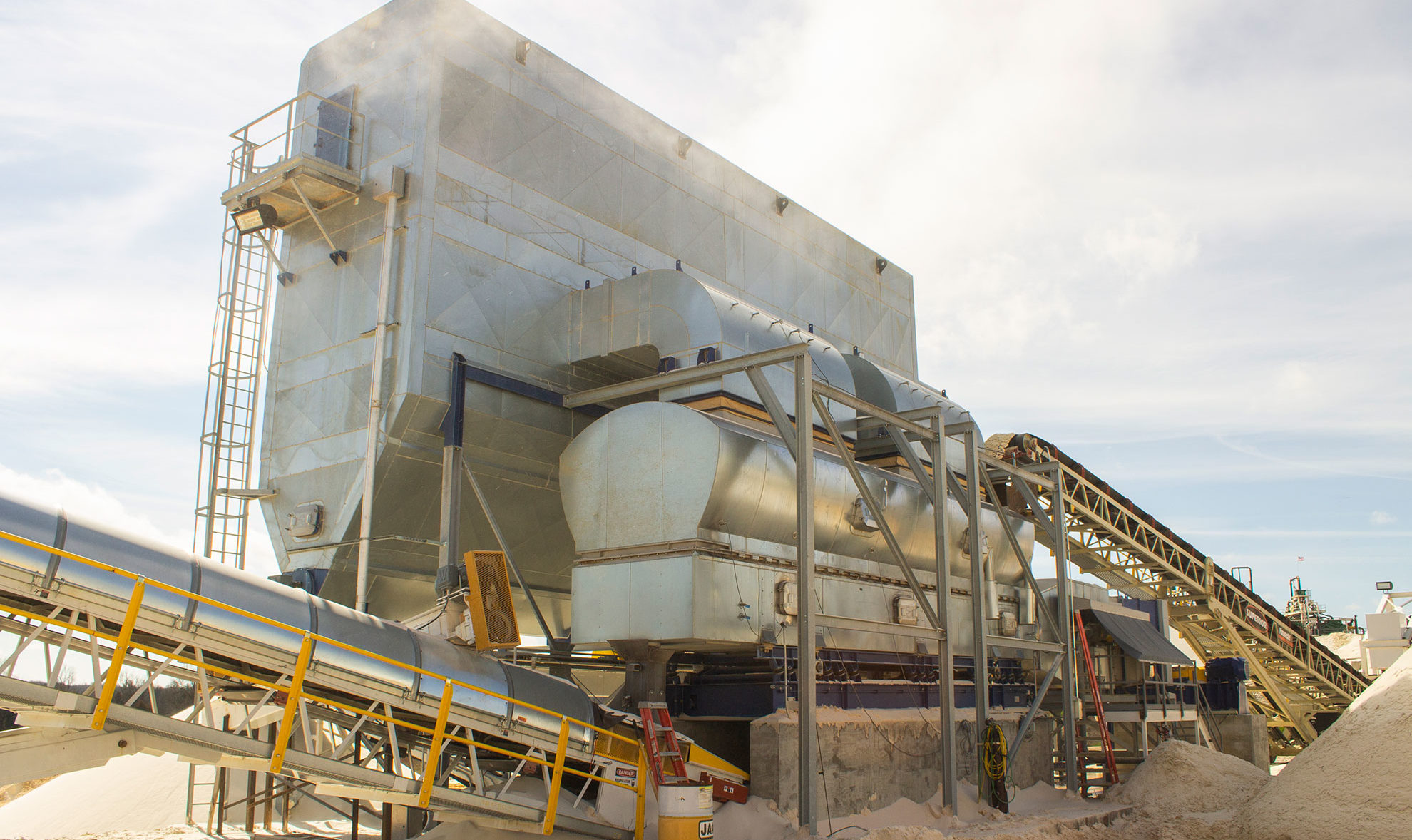Saving money with the Ventilex Fluid Bed Sand Dryer
The first step in the processing of sand, gravel and aggregates after mining is a washing and classification process. The material may be screened and stored but at some point moisture content needs to be reduced to meet a specification required for sale or further processing. Operating a sand dryer to dry your mineral product is frequently the greatest operating expense in your process and therefore with proper planning can be your greatest cost-saving opportunity.
Commonly used drying technologies in industry today for minerals and aggregates:
Rotary drum dryers
Rotary drum dryers are large rotating drums where the material cascades through a steam of hot air. Rotary dryers are often presented to have a “low initial cost advantage” but may require additional equipment and manpower to operate successfully. The main disadvantages are high operating costs due to unnecessary fuel consumption, elevated maintenance costs and additional manpower to operate. Rotary dryer systems often include basic controls that require frequent monitoring by an operator to regulate for changing conditions.
Static fluid bed dryers
Static fluid bed dryers utilize large volumes of heated air to fluidize the product. In practice, these dryers have thicker product layers that require larger blowers to keep the product suspended in the air stream. This process offers improved fuel efficient because the increased product layer retains heat and thermal heat transfer is maximized. This dryer may offer the advantages of low initial cost and simplicity of operation but product flexibility will suffer. Its main disadvantage is that the dryer is designed for and requires a consistent and uniform material size. If oversized, out-of-spec material is introduced into the dryer, it will not exit, but remain inside and will eventually prevent operation. At some point in time, the dryer will have to be shut down and cleaned out. Static fluid bed dryers are most suitable for processes that have little process variation. If the input mix/size varies, use of a static fluid bed dryer is not advisable. Static dryer systems often include basic controls that require frequent monitoring by an operator to regulate for changing conditions.
Vibrating fluid bed dryers
Vibrating fluid bed dryers use a large drive mechanism with the bed mounted on springs like a vibrating conveyor to move product through the dryer. They have the advantage that they can process a wider range of products. The main disadvantage is that the dryer and the product is subjected to significant g-forces. These high forces typically cause friable product to break apart creating unnecessary and often unwanted fines and waste. In addition, the high g-forces will be transferred to the surrounding structures resulting in additional installation requirements, premature equipment wear, premature instrument wear and elevated noise concerns. case the bed case to fracture and the drive mechanisms are subject to periodic refurbishment. Instrumentation takes a beating too, so the control systems are typically very basic. Vibratory dryer systems often include improved controls that require less monitoring by an operator to regulate for changing conditions.
Shaking fluid bed dryers
Shaking fluid bed dryers solve the high g-force issue by eliminating the need for vibration and includes a more advanced control systems that eliminates the need for continuous operator involvement. Product is moved through the dryer by a gentle shaking motion, Low Frequency / High Amplitude, that moves it forward in a step by step, uniform manner referred to as plug flow. The g-force issue is eliminated allowing for smallest possible product deterioration, reduced foundation requirements and minimal noise output. A shaking fluid bed dryer system typically has a greater initial cost but the lowest life cycle cost due to substantial savings in fuel consumption and maintenance costs.
How the Ventilex Fluid Bed Sand Dryer works
The Ventilex Fluid Bed Sand Dryer features sophisticated control systems that are capable of adjusting the burner perfectly in real time to match whatever moisture content is in the sand at any point in time, which results in a perfectly dried product without the added expense of overheating it.
A Ventilex Fluid Bed Dryer/Cooler is a machine in which a continuous flow of wet granular material is dried and subsequently cooled. Drying of the material occurs because of the direct contact between the sand and the hot drying air that is blown through a layer of the product.
The air velocity of the drying air is adjusted in such a way that the layer of product is maintained in a fluidized state. The same principle applies for cooling, only the cooling is with ambient air or with conditioned (cooled) air.
Require Service?
Advantages of the Ventilex Fluid Bed Sand Dryer:
- The drying air is evenly distributed over the product. As a result, the drying air supply temperature and the product exit temperature can be maintained at constant, economical levels, resulting in lower energy costs.
- Fuel consumption is low because of the improved thermal efficiency.
- The operation of the continuous fluid bed dryer/cooler is not influenced by weather conditions and changes in wind velocity and direction. Control is therefore easier, and product quality is constant and maintenance costs are lower.
- Sturdy stainless steel construction backed by Dutch excellence in engineering and manufacturing requires less maintenance.
- Stray oversize pieces of material finding their way into a static fluid bed will not be carried out of the machine by the flow of air and will have to be removed manually from time to time. In the case of a continuous fluid bed such oversize lumps are simply and easily conveyed out of the system in the course of normal operation.
